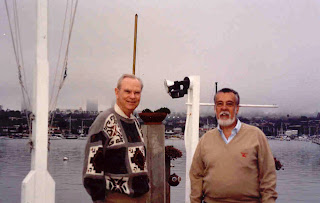William F. House, M.D.
Bill House is my guru, my otological model, my friend. Most probably his name will appear many times in this blog.
His associate Jim Sheehy used to say that he is a “far out thinker.” His inventive capacity has no limits. He changed otology and neurotology. Making changes in Medicine is a complex thing. Many people resent it. Many people make unfavorable comments. Many people try to block progress. The history of otology tells us that all new procedures were severely criticized before becoming standardized techniques.
I am happy that Bill decided to write a memoir telling us how controversial most of his work was, something that young otologists do not realize. Very aptly, his book is called The Struggles of a Medical Innovator – Cochlear Implants and Other Ear Surgeries. The Table of Contents, in itself, is a list of his accomplishments in the areas of otosclerosis, the facial nerve recess, surgery for Menière’s Disease, the middle fossa and translabyrinthine approaches for acoustic tumors, the cochlear implants, the brainstem implants.
In addition to an understanding of how his work gradually developed, he tells us many stories. Many of them were new to me, in spite of the fact that we have been together many times and discussed many things – most of them non-medical.
We were together in many medical meetings and often we and our wives would take a trip together. One of them was the most unforgettable: right after the First Implant Meeting in Los Angeles we went to the British Virgin Islands, spending one week in Peter Island and one week in a boat.
He has been in Brazil many times. The most recent one was the commemoration of the 30th anniversary of my first cochlear implant, in 2007. He gave us a wonderful lecture on the Future of Otology.
He has retired, but he is still creating things. And his ideas, as always, are first-quality ideas. He has just developed a hearing test for new-born babies – using the mother’s voice as the audiological stimulus. It picks up central auditory problems. Present day newborn infant screening tests cannot do that.
His associate Jim Sheehy used to say that he is a “far out thinker.” His inventive capacity has no limits. He changed otology and neurotology. Making changes in Medicine is a complex thing. Many people resent it. Many people make unfavorable comments. Many people try to block progress. The history of otology tells us that all new procedures were severely criticized before becoming standardized techniques.
I am happy that Bill decided to write a memoir telling us how controversial most of his work was, something that young otologists do not realize. Very aptly, his book is called The Struggles of a Medical Innovator – Cochlear Implants and Other Ear Surgeries. The Table of Contents, in itself, is a list of his accomplishments in the areas of otosclerosis, the facial nerve recess, surgery for Menière’s Disease, the middle fossa and translabyrinthine approaches for acoustic tumors, the cochlear implants, the brainstem implants.
In addition to an understanding of how his work gradually developed, he tells us many stories. Many of them were new to me, in spite of the fact that we have been together many times and discussed many things – most of them non-medical.
Bill and I in his house in Newport Beach, California (1992)
We were together in many medical meetings and often we and our wives would take a trip together. One of them was the most unforgettable: right after the First Implant Meeting in Los Angeles we went to the British Virgin Islands, spending one week in Peter Island and one week in a boat.
Bill, his wife June and I in Peter Island (1977)
My wife Marlene in Peter Island (1977)
He has been in Brazil many times. The most recent one was the commemoration of the 30th anniversary of my first cochlear implant, in 2007. He gave us a wonderful lecture on the Future of Otology.
Bill and Marlene during the Symposium "30 years of Cochlear Implants in Brazil," in 2007.
He has retired, but he is still creating things. And his ideas, as always, are first-quality ideas. He has just developed a hearing test for new-born babies – using the mother’s voice as the audiological stimulus. It picks up central auditory problems. Present day newborn infant screening tests cannot do that.







Gazelles Coach Australia
ReplyDeleteStrategy & Execution Advisors are the Business Strategy & Execution Experts. We have worked with thousands of companies over the past 16 years to help them craft breakthrough strategies and execute to deliver on these strategies.
Go To:>> http://strategyandexecution.com.au/